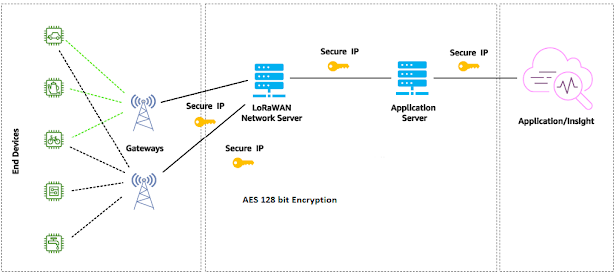We all are now very well acquainted
with the LoRaWAN Technology. Smart Homes, Smart Cities, Industrial Automation,
Smart Health & Agriculture are some of the areas where this technology
gained a foothold idiom.
As per the LoRaWAN Architecture,
numerous end device sensors are communicating with LoRaWAN Gateways
predominantly over LoRa Physical Layer for License free Sub Giga Hertz
frequencies.
The Communication requires LoRa Network Server & Application Server because the LoRaWAN Gateway is just
like a packet forwarder & acts as a bridge between the End Node Sensors
& LoRa Network Server.
The LoRaWAN Gateway listens to all
packets coming from the Sensors, in its vicinity & transfers it to Cloud
Network. There is an IP connection between the Gateway & the LoRa Network
Server.
Here the major key to understanding
is why the Network Server is the master of the overall Network System.
The Network Server is the core of
every LoRaWAN Network. It enables connectivity, management & monitoring of
Devices, Gateways & End Sensor Nodes. The main objective of the LNS is the
Reliability, Security & Scalability of Data Routing throughout the LoRaWAN
Network.
It validates the authenticity and
integrity of devices, de-duplicates uplinks, selects the gateways used for
downlink, and sends ADR commands to optimize the data rate of devices. It can
also register users, applications, devices, and gateways. This will allow for
running a reliable, scalable, multi-tenant network, distributed over multiple
regions worldwide.
There are two main types of Network
servers, one is integrated & the other is Cloud-based. The Cloud Based
Server uses several Datacenter Capabilities with multiple tenants and different
Geographical Regions.
An Integrated LNS is one that runs on the same hardware platform as the LoRaWAN Gateway itself, reducing dependency on third-party LNS service providers & helping to realize some economies in individual deployments.
When deciding between an integrated LNS or a cloud hosted LNS (available from service providers such as TTN or Loraiot), it is important to consider the relative strengths and weaknesses of each solution. Generally, if the application only requires a small number of sensors in a localized environment then an Integrated LNS can be a good solution. However, the management and scalability of such a solution will always be more limited than a network (or a network of networks) orchestrated from the cloud.




No comments:
Post a Comment